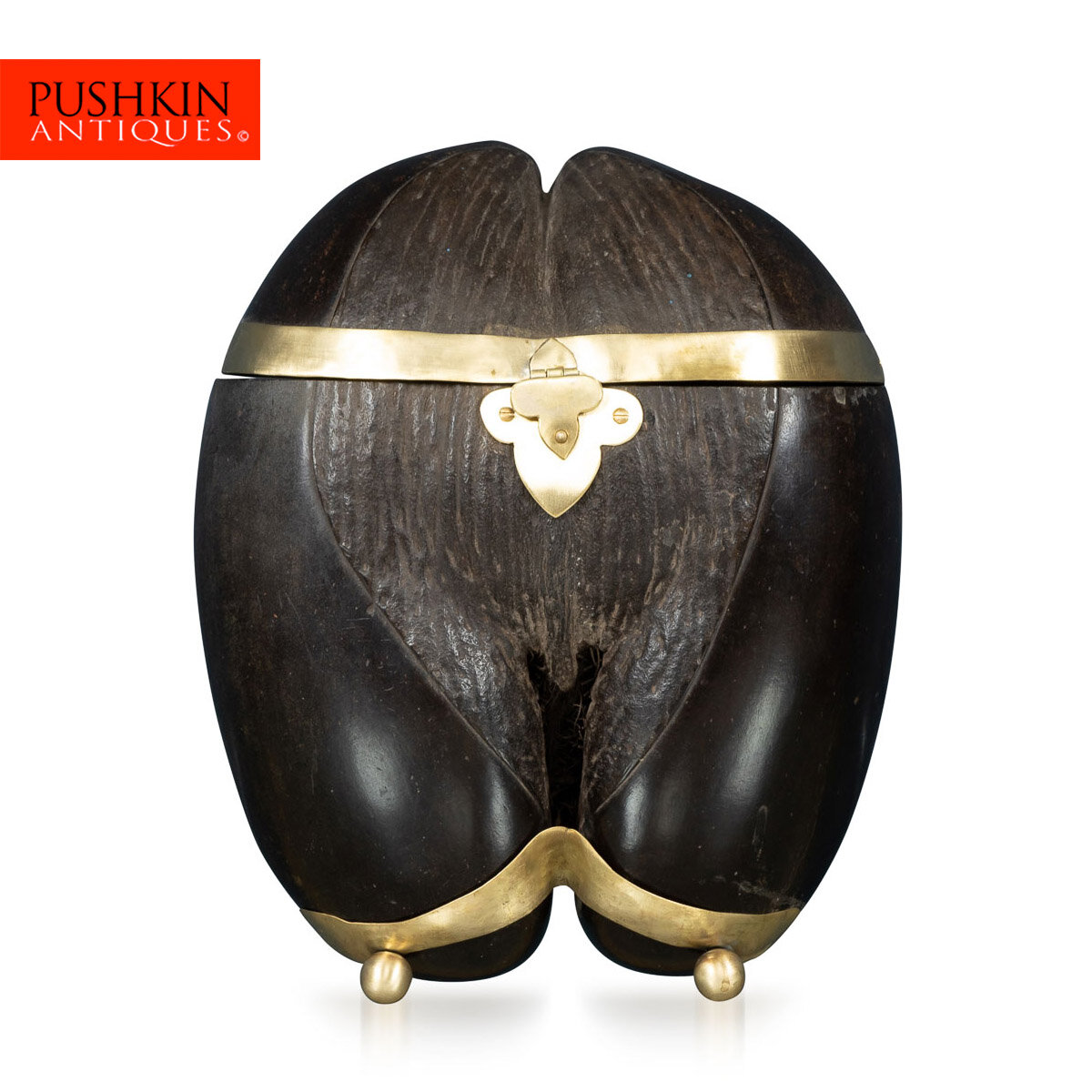 Image 1 of 8
Image 1 of 8

 Image 2 of 8
Image 2 of 8

 Image 3 of 8
Image 3 of 8

 Image 4 of 8
Image 4 of 8

 Image 5 of 8
Image 5 of 8

 Image 6 of 8
Image 6 of 8

 Image 7 of 8
Image 7 of 8

 Image 8 of 8
Image 8 of 8









UNIQUE COCO-DE-MER NUT WITH LOVELY PROVENANCE, SEYCHELLES c.1941
Reference Number: B6874
Reference Number: B6874
Reference Number: B6874
DESCRIPTION
A beautiful antique coco de mer nut mounted on a wooden plinth with a wonderful story, the underside with a typed paper label describing its history: “This sea coconut (Lodoicea Maldivica) was found at Cerf Island Lagoon (Seychelles) by Arthur Thomas Wood of the HMAS Sydney (II) (RAN) in January 1941.”
Able Seaman Arthur 'Tom' Wood was born in 1921 in Berry, New South Wales, Australia. He was the eldest child of Arthur and Ruby Wood and joined the Royal Australian Navy in 1938 at the age of 17 and a half. Tom carried out his training at HMAS Cerebus and then joined HMAS Sydney in 1939.
HMAS Sydney was on tour when war was declared in September 1939. It was ordered to serve in the Mediterranean Sea for escort duty. On 12 July 1940 HMAS Sydney was in the battle that sank the Italian ship Espero then on 19 July 1940 Sydney sank the Italian cruiser Bartolomeo Colleoni then returned to Australia when the Pacific War commenced. HMAS Sydney was based in Fremantle, Western Australia, where Tom met and married Vickie Marsden. That same week HMAS Sydney sailed on her last duty.
It therefore stands to reason that this coco de mer nut was found on her return voyage from the Mediterranean to Australia, and given to a family member or friend of Arthur Thomas Wood once it had docked in home waters.
On 19 November 1941 HMAS Sydney was returning from convoy duties in Java and proceeding south down the North West coast of Australia. What took place aboard the cruiser is a matter of conjecture, but it is likely that she sighted what appeared to be a harmless merchantman at about 4pm, some 130 miles west of Shark Bay, Western Australia.
Feigning innocence and claiming to be the Dutch ship Straat Malakka, HSK Kormoran by various subterfuges, avoided replying to HMAS Sydney's repeated signals requesting identification. Finally, when concealment of her true identity was no longer possible, and the advantage of surprise, the raider opened fire with all armament at a range of 'somewhat more than a mile’.
It is now believed that the raider’s first salvo destroyed HMAS Sydney's bridge, with the result that her primary control was immediately put out of action. HMAS Sydney's own guns opened fire almost simultaneously, and hits were scored on HSK Kormoran's engine room, starting a fire which would eventually cause its abandonment and loss. Early in the action the raider succeeded in torpedoing HMAS Sydney abreast the forward turrets, thus jamming their training. Sydney herself fired four torpedoes at the raider from local control but scored no hits. It was later estimated that during the short, brutal battle HMAS Sydney was hit at least 87 times by heavy shells from the German raider and with hundreds of lighter explosive bullets.
There were no survivors from HMAS Sydney, consisting of 645 crew members. It is likely the Captain, officers and 70% of the crew were killed very early on in the encounter. The 318 survivors from HSK Kormoran reported that HMAS Sydney was last seen heavily on fire and down by the bows, as a burning glow on the horizon. The survivors of the HSK Kormoran were interned in Australia until after the war.
In March 2008, a search organised by the Finding Sydney Foundation, in partnership with shipwreck investigator David Mearns, located the wrecks of HMAS Sydney and HSK Kormoran on the seabed in 20,112 nautical miles from the West Aaustralian, 12 miles from each other.
The loss of HMAS SYDNEY II is Australia’s greatest naval tragedy. Its disappearance in 1941 without a trace left a legacy of uncertainty for decades that was heightened by a media blackout in the following years of the disaster.
The photograph of Able Seaman 'Tom' Wood and the existence of the coco de mer nut that he collected for his loved ones on the shores of the Seychelles in January 1941 puts a distinctly human face to the months on board HMAS Sydney leading up to its fate on the 19th November 1941. In the photograph, Able Seaman Arthur Thomas Wood is in his Royal Australian Navy uniform holding the hands of a young boy who stands before him. This is part of a collection of photographs of Arthur Thomas Wood who served as an Able Seaman on HMAS Sydney from 1938 to 1941. He was only 20 years old when he was lost with the rest of the HMAS Sydney’s crew on 19 November, 1941
The coco de mer nut (scientific name: Lodoicea) is a very rare seed native to the Seychelles in the Indian Ocean, its suggestive form leading to all sorts of legendary fables. Many were collected by seafarers and gifted to royalty and noblemen who saw them symbols of fertility and embellished them with jewels and precious metals.
Until the source of the nut was discovered in 1768, it was believed to grow on a mythical tree at the bottom of the sea because it was once believed to be a sea-bean or drift seed, a seed evolved to be dispersed by the sea. However, it is now known that the viable nut is too dense to float, and only rotted out nuts can be found on the sea surface, thus explaining why the trees are limited in range to just two islands.
CONDITION
In Good Condition - Wear as expected.
SIZE
Height: 40cm
Width: 32cm
Depth: 15cm
















